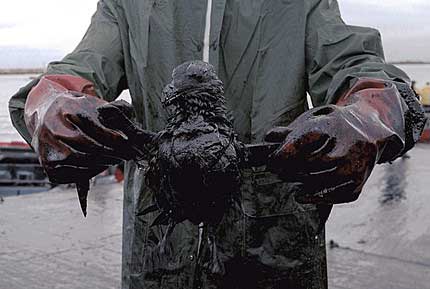2010 Oil Spill Answers (Pt. 2) May 4, 2010
Posted by Jamie Friedland in Offshore Drilling, Politics.Tags: BP, Exxon, Exxon Valdez, fishermen, Gulf of Mexico, Halliburton, Offshore Drilling, Oil, Oil Spill, Oil Spill 2010, wildlife
4 comments
***I have added a new page to this site to let you more easily find the answers to your oil spill questions. It is the new “2010 oil spill/offshore drilling answers” tab next to the “about me” at the top of each page, or you can click here.***
In a previous post, I have addressed the following questions:
- What was the oil rig doing?
- What caused the explosion?
- How much oil is spilling?
- Where is the oil spilling from?
- Can we stop the spill? How?
- Could the spill get any worse?
I also answered why BP is responsible for this spill/explained what blowout preventers are, and, just a few weeks before this all began, I wrote a detailed post explaining why offshore drilling is dangerous and not an energy solution.
In this post, I will address these questions:
- What does this mean for people who live along the Gulf?
- What does this mean for the wildlife in the Gulf?
- How does this compare to the Exxon Valdez spill?
- How is Halliburton involved?
Also, the New York Times has a well-done, simple day-by-day map tracking the spill here.
What does this spill mean for the people who live along the Gulf?
This ongoing spill is going to prove catastrophic for many people around the Gulf. Not in loss of life, but through loss of livelihood. It has been estimated that the Gulf of Mexico is responsible for $31.8 billion annually in sustainable activities such as fishing (commercial and recreational) and tourism. As we have now seen, whatever money there is to be made from offshore drilling there, it completely jeopardizes the rest of the Gulf’s economic activities.
Unlike oil profits, which are extractive, one-time transactions that only enrich giant oil companies and their shareholders, the income from these other activities is sustainable and dispersed among millions of Gulf coast residents. It is how thousands upon thousands of fishermen and shrimpers and tourism operators have supported their families for decades and were planning to do so this year and into the future.
The iconic Exxon Valdez spill in Alaska offers some insight about what to expect for the Gulf region. 21 years after that spill, crude oil still remains on or just under the surface of some of the regions beaches. Fishing was out of the question for years. Indeed, many Gulf fishermen have already brought in their last harvest for some time to come: fishing has already been suspended in large parts of the Gulf. If fishery populations are decimated, those men and women might not be able to go to work for many years after we get the oil cleaned up.
That is what happened in Alaska after Exxon Valdez. Unable to work, fishermen remained at home as their bank accounts and family lives became depleted. Alcoholism, bankruptcy, suicide, domestic violence, and divorce rates rose significantly in the area. Men who have fished their entire lives and know how to do nothing else were suddenly powerless to provide for their families. And for what?
What does this spill mean for the wildlife in the Gulf?
The Exxon Valdez Oil Spill Trustee council estimated 250,000 seabirds, 2,800 sea otters, 300 harbor seals, 250 bald eagles, up to 22 killer whales died along with billions of salmon and herring eggs. Some species have recovered, some never did.
But the Gulf is not Alaska. Louisiana is the 2nd largest seafood-producing state in the country (after Alaska). In fact, much of the seafood served around the country, even in crab shacks along the Chesapeake Bay(!), is actually flown in from the Gulf. That will now stop. When such fragile ecosystems are disrupted so drastically, the effects can be very long-term.
The wetlands along the Gulf of Mexico, particularly in Louisiana, are not wildlife sanctuaries simply because they are a beautiful part of our country’s natural heritage. Many oceanic fish lay their eggs in the protection of those marshes. Crabs, shrimp, and oysters are completely dependent upon those coastal areas. If toxic oil reaches them, we will likely see population crashes across the spectrum of marine wildlife.
But the oil has devastating effects in the open water as well. The only living coral reef system in the continental U.S., fragilely situated along the Florida Keys, is imperiled. This spill spells doom for everything from sport-fishers’ Atlantic tarpon to the already decimated bluefin tuna population, shrimp, endangered sea turtles, essentially all Gulf commercial fisheries, migrating sea birds and marine mammals.
For a more detailed look at the threat to the region’s wildlife, I suggest Dr. Sally Kneidel’s May 2 post.
How does this compare to the Exxon Valdez spill?
Regardless of what happens in the next few days or weeks, Exxon Valdez and Horizon Deepwater will be the two worst oil spills in American history. As you may recall, the Exxon Valdez was an oil tanker that ran aground in Alaska, spilling nearly 11 million gallons of oil into the Prince Williams Sound. That accident was caused by the negligence of a captain who was accused of being drunk at the time. That is different from this situation.
However, the Valdez spill was also caused by a giant oil company’s refusal to adopt common-sense safety precautions that would cost a little extra money up front (although save the company literally billions by preventing oil spills), and in that respect, these two spills are very similar. Exxon took the inexplicable position of refusing to use double-hulled tankers even as the rest of the oil companies adopted the practice as commonplace and even demanded by law around the world.
More about that situation and Exxon Valdez in general here.
What makes this spill so terrifying is that its not really a spill. It is what’s known as a “blowout,” “gusher,” or sometimes a “wild well”: an uncapped well connected an oil reservoir under high pressure. Because of that pressure, oil will flow, sometimes violently, from the well as long as it remains uncapped. This brings us to the crucial difference between Exxon Valdez and this situation.
The Exxon Valdez was an oil tanker with a capacity of 1.48 million barrels of oil. Don’t get me wrong, that is a lot of oil and capable of immense ecological damage, but there was a finite amount of oil that could be spilled from that tanker. It is estimated that about 260,000 barrels spilled from the tanker. But in the Gulf, we are dealing with an ongoing spill from an entire reservoir.
Instead of the Exxon Valdez’s 1.5 million barrels, the reservoir in question is estimated to hold 100 million barrels of oil (4,200,000,000 gallons). These will continue to leak until the well is successfully plugged. And there is legitimate concern that the rate of the leak could increase by a full order of magnitude such that as much oil as spilled from the Exxon Valdez would defile the Gulf every 2 days. That is not a typo.
How is Halliburton involved?
Halliburton is the world’s second largest oilfield services corporation. Outside of the drilling industry, it is most [in]famous for being the subject of several controversies involving the 2003 Iraq War and former Vice President Dick Cheney’s lingering involvement with the corporation following his retirement as Chairman and CEO to run in the 2000 election.
Halliburton has confirmed that it provided numerous services for the Deepwater Horizon rig. Among them was a process known as “cementing”: plugging holes in the pipeline with cement. This practice is supposed to prevent oil and natural gas from escaping from the well at the drill site (except through the pipe).
The investigations about what happened and who is at fault have only just begun and obviously are secondary concerns after stopping this disaster, but experts are already suggesting that a faulty cementing job by Halliburton could be the culprit. Faulty cementing has already been identified as a major cause of blowouts, and Halliburton has actually been implicated in the massive blowout off the coast of Australia last year! I will be writing more about this and other blowouts later this week. It is no surprise, then, that the company is already charged in some of the first law suits that have been filed so far.
A government report released in 2007 examined 39 rig blowouts in the Gulf of Mexico between 1992 and 2006. Improper cementing was determined to be a contributing factor in 18 of the incidents.
More updates and answers to come.



